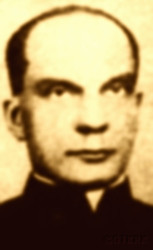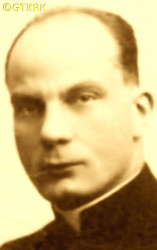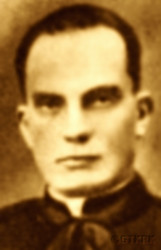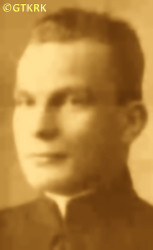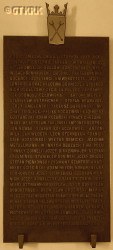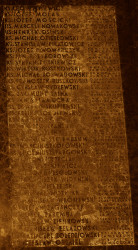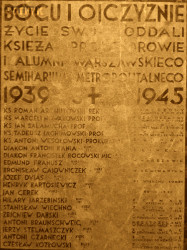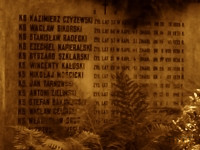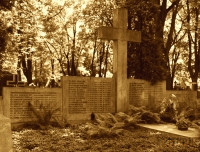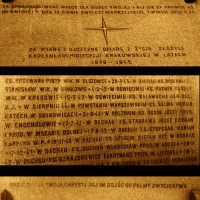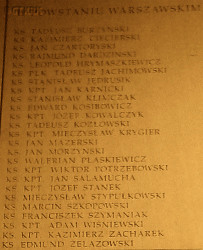Roman Catholic
St Sigismund parish
05-507 Słomczyn
85 Wiślana Str.
Konstancin deanery
Warsaw archdiocese, Poland
full list:
displayClick to display full list

searchClick to search full list by categories
wyświetlKliknij by wyświetlić pełną listę po polsku

szukajKliknij by przeszukać listę wg kategorii po polsku

Martyrology of the clergy — Poland
XX century (1914 – 1989)
personal data
surname
SALAMUCHA
forename(s)
John (pl. Jan)
function
diocesan priest
creed
Latin (Roman Catholic) Church RCmore on
en.wikipedia.org
[access: 2014.09.21]
diocese / province
Warsaw archdiocesemore on
en.wikipedia.org
[access: 2013.05.19]
RC Military Ordinariate of Polandmore on
en.wikipedia.org
[access: 2014.12.20]
academic distinctions
Habilitation Doctor of Theology
Magister Aggregatus MAgg
Doctor of Philosophy
honorary titles
„Cross of Valour”more on
en.wikipedia.org
[access: 2019.04.16]
date and place
of death
11.08.1944

Warsawtoday: Warsaw city pov., Masovia voiv., Poland
more on
en.wikipedia.org
[access: 2021.10.09]
alt. dates and places
of death
03.08.1944, 12.08.1944
details of death
In 1920 took part — as a volunteer – medical officer — in the Polish–Russian war of 1919‐1921, in the troops of General Inspector of the Volunteer Army, General Joseph Haller, at the same time the commander of the Northern Front during the war.
After German invasion of Poland on 01.09.1939 (Russians invaded Poland 17 days later) and start of the World War II chaplain of 360th Infantry Regiment of Polish Army.
Takes part in defense of Warsaw besieged by Germans (Bem fortifications in the west of Warsaw among others).
Wounded.
After start of German occupation returns to Kraków.
There arrested by the Germans on 06.11.1939, among professors of Jagiellonian University.
Jailed in Kraków — held in Montelupich Str. prison and barracks of 20th Infantry Regiment at Mazowiecka Str., among others.
Next moved do Wrocław and on 28.11.1939 transported to KL Sachsenhausen concentration camp.
Next on 14.12.1940 (or on 04.04.1940) moved to KL Dachau concentration camp.
On 04.01.1941 released.
Returned to German‐run General Governorate.
Ministered in Warsaw.
Became Polish National Resistance Army NSZ (part of Polish Clandestine State) chaplain.
Lectured at clandestine Humanities Western Land's University (part of Polish Clandestine State).
On 25.12.1942, in the undergroun „Struggle”magazine, published an article „The face of love”, in which asked questions about the love of enemies — declared that he would defend his homeland while rejecting the hatred for the enemy (at the same time was also working on the „On Christian Style in Philosophy” paper).
On the day of the outbreak of the Warsaw Uprising, 01.08.1944, was the vice‐dean of the North District of Warsaw deanery and the dean of the 4th Ochota District of the clandestine Home Army AK — that day at 3.00 pm, just before the outbreak of the uprising (at the so‐called „W” hour: 5.00 pm), organized a meeting / briefing of all chaplains of the Warsaw district Ochota.
Became a chaplain in the hospital at 60 Wawelska Str. — which was in the center of the so‐called Wawelska Redoubt.
When on 11.08.1941, its defense was no longer possible and the insurgents left the region through the sewers to Śródmieście district, stayed behind in the hospital with the wounded.
Murdered — despite hosting the white flag — by Russian RONA troops fighting alongside German SS units.
Prob. shot, alternatively killed by a blast of a grenade thrown into the basement where he was hiding.
prisoner camp's numbers
22337Click to display source page (KL DachauClick to display the description)
cause of death
mass murder
perpetrators
Germans / Russians
sites and events
Wola district massacresClick to display the description, Warsaw UprisingClick to display the description, GeneralgouvernementClick to display the description, KL DachauClick to display the description, KL SachsenhausenClick to display the description, Cracow (Montelupich)Click to display the description, Sonderaktion KrakauClick to display the description, «Intelligenzaktion»Click to display the description, Ribbentrop‐MolotovClick to display the description, Pius XI's encyclicalsClick to display the description, Polish‐Russian war of 1919‐1921Click to display the description
date and place
of birth
10.06.1903

Warsawtoday: Warsaw city pov., Masovia voiv., Poland
more on
en.wikipedia.org
[access: 2021.10.09]
parents
SALAMUCHA Andrew
🞲 ?, ? — 🕆 ?, ?

MARCINIAK Stanislava
🞲 ?, ? — 🕆 ?, ?
presbyter (holy orders)
ordination
21.02.1926

Warsawtoday: Warsaw city pov., Masovia voiv., Poland
more on
en.wikipedia.org
[access: 2021.10.09]
RC chapel (in Bp Stanislav Gall house)
positions held
1941 – 1944
vicar — Warsawtoday: Warsaw city pov., Masovia voiv., Poland
more on
en.wikipedia.org
[access: 2021.10.09] ⋄ Immaculate Conception of the Blessed Virgin Mary RC church ⋄ St James the Apostle RC parish ⋄ Warsaw‐extra‐Urbemdeanery name
today: Warsaw city pov., Masovia voiv., Poland RC deanery
from 06.12.1938
supernumerary professor — Krakówtoday: Kraków city pov., Lesser Poland voiv., Poland
more on
en.wikipedia.org
[access: 2021.06.07] ⋄ Department of Christian Philosophy, Theological Department („Bobolanum” college), Jagiellonian University UJ — lecturer in the theory of knowledge, logic, theodicy, cosmology and the history of ancient philosophy
1936 – 1938
deputy professor — Krakówtoday: Kraków city pov., Lesser Poland voiv., Poland
more on
en.wikipedia.org
[access: 2021.06.07] ⋄ Department of Christian Philosophy, Theological Department („Bobolanum” college), Jagiellonian University UJ — lecturer in the theory of knowledge, logic, theodicy, cosmology and the history of ancient philosophy
1936
postdoctoral degree (habilitation) — Krakówtoday: Kraków city pov., Lesser Poland voiv., Poland
more on
en.wikipedia.org
[access: 2021.06.07] ⋄ Department of Christian Philosophy, Theological Department („Bobolanum” college), Jagiellonian University UJ — habilitation thesis „The concept of deduction in Aristotle and St Thomas Aquinas”, approved on 17.11.1936 (earlier, in 1933, nomination was rejected by the Ministry of Religious Affairs and Public Enlightenment, for the formal reason „lack of matura i.e. high school diploma”)
1934 – 1936
lecturer — Krakówtoday: Kraków city pov., Lesser Poland voiv., Poland
more on
en.wikipedia.org
[access: 2021.06.07] ⋄ Department of Christian Philosophy, Theological Department („Bobolanum” college), Jagiellonian University UJ
1933 – 1934
vicar — Warsawtoday: Warsaw city pov., Masovia voiv., Poland
more on
en.wikipedia.org
[access: 2021.10.09] ⋄ Immaculate Conception of the Blessed Virgin Mary RC church ⋄ St James the Apostle RC parish ⋄ Warsaw‐extra‐Urbemdeanery name
today: Warsaw city pov., Masovia voiv., Poland RC deanery
1929 – 1933
professor — Warsawtoday: Warsaw city pov., Masovia voiv., Poland
more on
en.wikipedia.org
[access: 2021.10.09] ⋄ Metropolitan Theological Seminary — lecturer in philosophy
c. 1929
vicar — Wiązownatoday: Wiązowna gm., Otwock pov., Masovia voiv., Poland
more on
en.wikipedia.org
[access: 2022.01.28] ⋄ St Adalbert the Bishop and Martyr RC parish ⋄ Warsaw‐Praskideanery name
today: Warsaw city pov., Masovia voiv., Poland RC deanery
1927 – 1929
student — Rometoday: Rome prov., Lazio reg., Italy
more on
en.wikipedia.org
[access: 2021.12.18] ⋄ philosophy, „Gregorianum” [i.e. Lat. Pontificia Universitas Gregoriana (Eng. Pontifical Gregorian University)] — post–doctoral specialised studies on the works and figures of Aristotle and St Thomas Aquinas, crowned with the title of magister aggregates Universitas Gregorianae
1925 – 1927
PhD student — Warsawtoday: Warsaw city pov., Masovia voiv., Poland
more on
en.wikipedia.org
[access: 2021.10.09] ⋄ mathematical logic, Department of Theology, University of Warsaw [i.e. University of Warsaw (from 1945) / clandestine University (1939‐1945) / Joseph Piłsudski University (1935‐1939) / University of Warsaw (1915‐1935) / Imperial University of Warsaw (1870‐1915)] — PhD thesis „Aristotle's theory of modal implication”, public defense on 24.10.1927
1923 – 1925
student — Warsawtoday: Warsaw city pov., Masovia voiv., Poland
more on
en.wikipedia.org
[access: 2021.10.09] ⋄ Department of Catholic Theology, University of Warsaw [i.e. University of Warsaw (from 1945) / clandestine University (1939‐1945) / Joseph Piłsudski University (1935‐1939) / University of Warsaw (1915‐1935) / Imperial University of Warsaw (1870‐1915)] — postgraduate specialised studies, crowned on 30.11.1926 with the title of Master of Sacred Theology for the thesis „On the 'relationship' category”; also: participant of lectures on human physiology at the Faculty of Medicine
1919 – 1925
student — Warsawtoday: Warsaw city pov., Masovia voiv., Poland
more on
en.wikipedia.org
[access: 2021.10.09] ⋄ philosophy and theology, Metropolitan Theological Seminary
sites and events
descriptions
Wola district massacres: Mass extermination of the inhabitants of Warsaw Wola and Ochota districts, perpetrated by the Germans in the first days of Warsaw Uprising. Approx. 38,000‐65,000 Poles, men, women and children were massacred (the peak of the barbarian killings took place on 05‐07.08.1944). The massacre — genocide in fact — was in direct response to Adolf Hitler’s order to crash and destroy Warsaw and kill all of its citizens and was perpetrated by German SS units and Russian SS RONA units (with Belarusian contingent) collaborating with them. (more on: pl.wikipedia.orgClick to attempt to display webpage
[access: 2021.12.19])
Warsaw Uprising: Lasted from 01.08.1944 till 03.10.1944. Was an attempt to liberate Polish capital from occupying Germans by the Polish Clandestine State — a unique in the history of the world political structure on the territories occupied by the Germans, effectively governing clandestinely in Poland — and by fighting on its behalf underground military units, mainly of Home Army (former Armed Struggle Association ZWZ) and National Armed Forced (NSZ). At the same time Russians stopped on purpose the offensive on all front, halted on the other bank of Vistula river and watched calmly the annihilation of the city, refusing even the mid‐landing rights to the Allied planes carrying weapons and supplies to the insurgents from Italy. During the Uprising Germans murdered approx. 200,000 Poles, mainly civilians. Approx. 200 priests and nuns died in fighting or were murdered by the Germans, many in mass executions. (more on: en.wikipedia.orgClick to attempt to display webpage
[access: 2013.08.17])
Generalgouvernement: After the Polish defeat in the 09.1939 campaign, which was the result of the Ribbentrop‐Molotov Pact and constituted the first stage of World War II, and the beginning of German occupation in part of Poland (in the other, eastern part of Poland, the Russian occupation began), the Germans divided the occupied Polish territory into five main regions. In two of them new German provinces were created, two other were incorporated into other provinces. However, the fifth part was treated separately, and in a political sense it was supposed to recreate the German idea from 1915 (during World War I, after the defeat of the Russians in the Battle of Gorlice in 05.1915) of creating a Polish enclave within Germany. Illegal in the sense of international law, i.e. Hague Convention, and public law, managed by the Germans according to separate laws — especially established for the Polish Germ. Untermenschen (Eng. subhumans) — till the Russian offensive in 1945 it constituted part of the Germ. Großdeutschland (Eng. Greater Germany). Till 31.07.1940 formally called Germ. Generalgouvernement für die besetzten polnischen Gebiete (Eng. General Government for the occupied Polish lands) — later simply Germ. Generalgouvernement (Eng. General Governorate), as in the years 1915‐1918. From 07.1941, i.e. after the German attack on 22.06.1941 against the erstwhile ally, the Russians, it also included the Galicia district, i.e. the Polish pre‐war south‐eastern voivodeships. A special criminal law was enacted and applied to Poles and Jews, allowing for the arbitrary administration of the death penalty regardless of the age of the „perpetrator”, and sanctioning the use of collective responsibility. After the end of the military conflict of the World War UU, the government of the Germ. Generalgouvernement was recognized as a criminal organization, and its leader, governor Hans Frank, guilty of war crimes and crimes against humanity and executed. (more on: en.wikipedia.orgClick to attempt to display webpage
[access: 2024.12.13])
KL Dachau: KL Dachau in German Bavaria, set up in 1933, became the main German Germ. Konzentrationslager (Eng. concentration camp) KL for Catholic priests and religious during World War II: On c. 09.11.1940, Reichsführer‐SS Heinrich Himmler, head of the SS, Gestapo and German police, as a result of the Vatican's intervention, decided to transfer all clergymen detained in various concentration camps to KL Dachau camp. The first major transports took place on 08.12.1940. In KL Dachau Germans held approx. 3,000 priests, including 1,800 Poles. The priests were forced to slave labor in the Germ. „Die Plantage” — the largest herb garden in Europe, managed by the genocidal SS, consisting of many greenhouses, laboratory buildings and arable land, where experiments with new natural medicines were conducted — for many hours, without breaks, without protective clothing, no food. They slaved in construction, e.g. of camp's crematorium. In the barracks ruled hunger, freezing cold in the winter and suffocating heat during the summer, especially acute in 1941‐1942. Prisoners suffered from bouts of illnesses, including tuberculosis. Many were victims of murderous „medical experiments” — in 11.1942 c. 20 were given phlegmon injections; in 07.1942 to 05.1944 c. 120 were used by for malaria experiments. More than 750 Polish clerics where murdered by the Germans, some brought to TA Hartheim euthanasia centre set up in Schloss Hartheim in Austria and murdered in gas chambers. At its peak KL Dachau concentration camps’ system had nearly 100 slave labour sub‐camps located throughout southern Germany and Austria. There were c. 32,000 documented deaths at the camp, and thousands perished without a trace. C. 10,000 of the 30,000 inmates were found sick at the time of liberation, on 29.04.1945, by the USA troops… (more on: www.kz-gedenkstaette-dachau.deClick to attempt to display webpage
[access: 2013.08.10], en.wikipedia.orgClick to attempt to display webpage
[access: 2016.05.30])
KL Sachsenhausen: In Germ. Konzentrationslager (Eng. concentration camp) KL Sachsenhausen, set up in the former Olympic village in 07.1936, hundreds of Polish priests were held in 1940, before being transported to KL Dachau. Some of them perished in KL Sachsenhausen. Murderous medical experiments on prisoners were carried out in the camp. In 1942‐1944 c. 140 prisoners slaved at manufacturing false British pounds, passports, visas, stamps and other documents. Other prisoners also had to do slave work, for Heinkel aircraft manufacturer, AEG and Siemens among others. On average c. 50,000 prisoners were held at any time. Altogether more than 200,000 inmates were in jailed in KL Sachsenhausen and its branched, out of which tens of thousands perished. Prior to Russian arrival mass evacuation was ordered by the Germans and c. 80,000 prisoners were marched west in so‐called „death marches” to other camps, i.e. KL Mauthausen‐Gusen and KL Bergen‐Belsen. The camp got liberated on 22.04.1945. After end of armed hostilities Germans set up there secret camp for German prisoners and „suspicious” Russian soldiers. (more on: en.wikipedia.orgClick to attempt to display webpage
[access: 2018.11.18])
Cracow (Montelupich): Cracow penal prison, during occupation run by the Germans — from 28.02.1941 by Germ. Geheime Staatspolizei (Eng. Secret State Police, known as Gestapo. In 1940‐1944 Germans jailed there approx. 50,000 prisoners, mainly Poles and Jews. Some of them were transported to KL Auschwitz concentration camp, some were executed. After cease in war effort the prison was used by UB — a Polish unit of Russian NKVD — as a prison for Polish independence resistance fighters, some of which were subsequently sent to prisons and slave labour camps in Russia. (more on: en.wikipedia.orgClick to attempt to display webpage
[access: 2014.10.31])
Sonderaktion Krakau: German operation against Cracow intelligentsia, part of a broader «Intelligenzaktion» against Polish intelligentsia, carried out in 1939‐1940. On 06.11.1939 Germans arrested 183/4 Cracow professors from prestigiuous universities, mainly Jagiellonian University. They were jailed in Montelupich prison in Cracow prior to being sent to KL Sachsenhausen concentration camp. 4 days later on 10.11.1939 Germans arrested 25 Jesuits from Cracow College. They were also jailed in Montelupich prison and then transported to German concentration camps where 7 of them perished. (more on: en.wikipedia.orgClick to attempt to display webpage
[access: 2015.03.01])
«Intelligenzaktion»: (Eng. „Action Intelligentsia”) — extermination program of Polish elites, mainly intelligentsia, executed by the Germans right from the start of the occupation in 09.1939 till around 05.1940, mainly on the lands directly incorporated into Germany but also in the so‐called Germ. Generalgouvernement (Eng. General Governorate) where it was called «AB‐aktion». During the first phase right after start of German occupation of Poland implemented as Germ. Unternehmen „Tannenberg” (Eng. „Tannenberg operation”) — plan based on proscription lists of Poles worked out by (Germ. Sonderfahndungsbuch Polen), regarded by Germans as specially dangerous to the German Reich. List contained names of c. 61,000 Poles. Altogether during this genocide Germans methodically murdered c. 50,000 teachers, priests, landowners, social and political activists and retired military. Further 50,000 were sent to concentration camps where most of them perished. (more on: en.wikipedia.orgClick to attempt to display webpage
[access: 2014.10.04])
Ribbentrop‐Molotov: Genocidal Russian‐German alliance pact between Russian leader Joseph Stalin and German leader Adolf Hitler signed on 23.08.1939 in Moscow by respective foreign ministers, Mr. Vyacheslav Molotov for Russia and Joachim von Ribbentrop for Germany. The pact sanctioned and was the direct cause of joint Russian and German invasion of Poland and the outbreak of the World War II in 09.1939. In a political sense, the pact was an attempt to restore the status quo ante before 1914, with one exception, namely the „commercial” exchange of the so‐called „Kingdom of Poland”, which in 1914 was part of the Russian Empire, fore Eastern Galicia (today's western Ukraine), in 1914 belonging to the Austro‐Hungarian Empire. Galicia, including Lviv, was to be taken over by the Russians, the „Kingdom of Poland” — under the name of the General Governorate — Germany. The resultant „war was one of the greatest calamities and dramas of humanity in history, for two atheistic and anti‐Christian ideologies — national and international socialism — rejected God and His fifth Decalogue commandment: Thou shall not kill!” (Abp Stanislav Gądecki, 01.09.2019). The decisions taken — backed up by the betrayal of the formal allies of Poland, France and Germany, which on 12.09.1939, at a joint conference in Abbeville, decided not to provide aid to attacked Poland and not to take military action against Germany (a clear breach of treaty obligations with Poland) — were on 28.09.1939 slightly altered and made more precise when a treaty on „German‐Russian boundaries and friendship” was agreed by the same murderous signatories. One of its findings was establishment of spheres of influence in Central and Eastern Europe and in consequence IV partition of Poland. In one of its secret annexes agreed, that: „the Signatories will not tolerate on its respective territories any Polish propaganda that affects the territory of the other Side. On their respective territories they will suppress all such propaganda and inform each other of the measures taken to accomplish it”. The agreements resulted in a series of meeting between two genocidal organization representing both sides — German Gestapo and Russian NKVD when coordination of efforts to exterminate Polish intelligentsia and Polish leading classes (in Germany called «Intelligenzaktion», in Russia took the form of Katyń massacres) where discussed. Resulted in deaths of hundreds of thousands of Polish intelligentsia, including thousands of priests presented here, and tens of millions of ordinary people,. The results of this Russian‐German pact lasted till 1989 and are still in evidence even today. (more on: en.wikipedia.orgClick to attempt to display webpage
[access: 2015.09.30])
Pius XI's encyclicals: Facing the creation of two totalitarian systems in Europe, which seemed to compete with each other, though there were more similarities than contradictions between them, Pope Pius XI issued in 03.1937 (within 5 days) two encyclicals. In the „Mit brennender Sorge” (Eng. „With Burning Concern”) published on 14.03.1938, condemned the national socialism prevailing in Germany. The Pope wrote: „Whoever, following the old Germanic‐pre‐Christian beliefs, puts various impersonal fate in the place of a personal God, denies the wisdom of God and Providence […], whoever exalts earthly values: race or nation, or state, or state system, representatives of state power or other fundamental values of human society, […] and makes them the highest standard of all values, including religious ones, and idolizes them, this one […] is far from true faith in God and from a worldview corresponding to such faith”. On 19.03.1937, published „Divini Redemptoris” (Eng. „Divine Redeemer”), in which criticized Russian communism, dialectical materialism and the class struggle theory. The Pope wrote: „Communism deprives man of freedom, and therefore the spiritual basis of all life norms. It deprives the human person of all his dignity and any moral support with which he could resist the onslaught of blind passions […] This is the new gospel that Bolshevik and godless communism preaches as a message of salvation and redemption of humanity”… Pius XI demanded that the established human law be subjected to the natural law of God , recommended the implementation of the ideal of a Christian state and society, and called on Catholics to resist. Two years later, National Socialist Germany and Communist Russia came together and started World War II. (more on: www.vatican.vaClick to attempt to display webpage
[access: 2023.05.28], www.vatican.vaClick to attempt to display webpage
[access: 2023.05.28])
Polish‐Russian war of 1919‐1921: War for independence of Poland and its borders. Poland regained independence in 1918 but had to fight for its borders with former imperial powers, in particular Russia. Russia planned to incite Bolshevik‐like revolutions in the Western Europe and thus invaded Poland. Russian invaders were defeated in 08.1920 in a battle called Warsaw battle („Vistula river miracle”, one of the 10 most important battles in history, according to some historians). Thanks to this victory Poland recaptured part of the lands lost during partitions of Poland in XVIII century, and Europe was saved from the genocidal Communism. (more on: en.wikipedia.orgClick to attempt to display webpage
[access: 2014.12.20])
sources
personal:
www.bj.uj.edu.plClick to attempt to display webpage
[access: 2012.11.23], www.1944.plClick to attempt to display webpage
[access: 2021.12.19], www.ipsb.nina.gov.plClick to attempt to display webpage
[access: 2019.10.13], mt514.plClick to attempt to display webpage
[access: 2023.03.10], pl.wikipedia.orgClick to attempt to display webpage
[access: 2013.05.19], www.1944.plClick to attempt to display webpage
[access: 2021.12.19]
bibliographical:
„Mysterium iniquitatis. Clergy and religious of the Latin rite murdered by Ukrainian nationalists in 1939‐1945”, Fr Józef Marecki, Institute of National Remembrance IPN, Kraków 2020
original images:
commons.wikimedia.orgClick to attempt to display webpage
[access: 2016.04.23], twitter.comClick to attempt to display webpage
[access: 2021.12.19], www.myheritage.plClick to attempt to display webpage
[access: 2016.04.23], www.facebook.comClick to attempt to display webpage
[access: 2019.10.13], aordycz-krakow.blogspot.comClick to attempt to display webpage
[access: 2014.10.04], commons.wikimedia.orgClick to attempt to display webpage
[access: 2016.04.23], cmentarze.um.warszawa.plClick to attempt to display webpage
[access: 2016.04.23], www.katedrapolowa.plClick to attempt to display webpage
[access: 2014.01.16]
LETTER to CUSTODIAN/ADMINISTRATOR
If you have an Email client on your communicator/computer — such as Mozilla Thunderbird, Windows Mail or Microsoft Outlook, described at WikipediaPatrz:
en.wikipedia.org, among others — try the link below, please:
LETTER to CUSTODIAN/ADMINISTRATORClick and try to call your own Email client
If however you do not run such a client or the above link is not active please send an email to the Custodian/Administrator using your account — in your customary email/correspondence engine — at the following address:

giving the following as the subject:
MARTYROLOGY: SALAMUCHA John
To return to the biography press below:
 Click to return to biography
Click to return to biography








